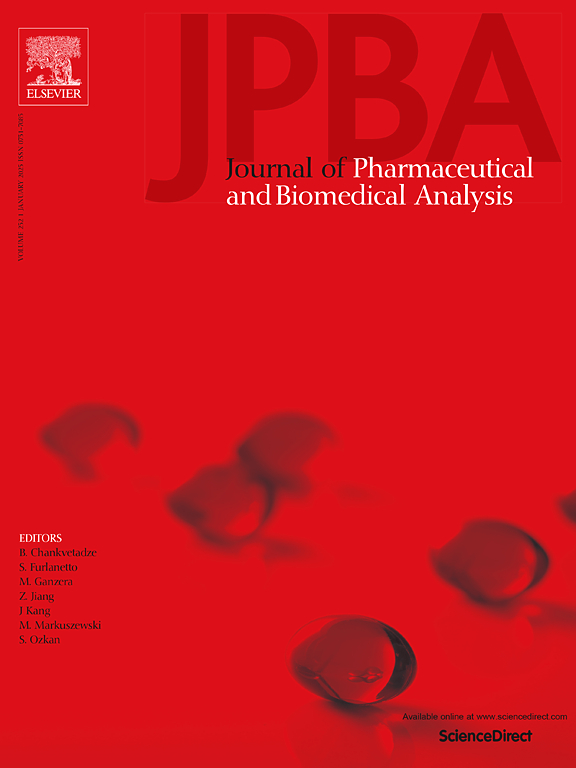Purification of testosterone and its metabolites in urine using two-dimensional high-performance liquid chromatography for 13C/12C ratios analysis by gas chromatography/combustion/isotope ratio mass spectrometry
IF 3.1
3区 医学
Q2 CHEMISTRY, ANALYTICAL
Journal of pharmaceutical and biomedical analysis
Pub Date : 2025-04-24
DOI:10.1016/j.jpba.2025.116921
引用次数: 0
Abstract
Two-dimensional high-performance liquid chromatography (2D-HPLC) is employed as a sample purification method for the isolation and enrichment of testosterone and its main metabolites in urine samples, thereby facilitating subsequent determination of 13C/12C ratios (δ13C) using Gas Chromatography/Combustion/Isotope Ratio Mass Spectrometry (GC/C/IRMS). The orthogonality of the HPLC columns was optimized by leveraging the distinct differences in polarity and steric hindrance effects between the stationary phases, enabling effective separation of endogenous interferents from testosterone in urine. Urine samples purified with 2D-HPLC exhibit significantly reduced matrix interferences in the fractions of testosterone (T), 5α-androstane-3α,17β-diol (5α-diol), and 5β-androstane-3α,17β-diol (5β-diol), thereby enhancing the accuracy and reliability of GC/C/IRMS analysis. The method achieves limit of quantification as low as 2 ng/mL for testosterone, and 3 ng/mL for both 5β-diol and 5α-diol. Furthermore, the simple instrument configuration enables direct transfer of 1D-purified fractions to 2D-HPLC for further isolation and enrichment, providing a flexible and efficient workflow for method development, particularly in handling complex biological matrices.
采用二维高效液相色谱法纯化尿液中睾酮及其代谢物,并采用气相色谱/燃烧/同位素比值质谱法分析13C/12C比值
采用二维高效液相色谱法(2D-HPLC)对尿样中睾酮及其主要代谢物进行分离富集,便于后续气相色谱/燃烧/同位素比质谱法(GC/C/IRMS)测定13C/12C比值(δ13C)。利用固定相之间极性和位阻效应的明显差异,优化了色谱柱的正交性,从而有效地分离了尿液中内源性干扰物和睾酮。经2D-HPLC纯化后的尿液样品,睾酮(T)、5α-雄甾烷-3α、17β-二醇(5α-二醇)和5β-雄甾烷-3α、17β-二醇(5β-二醇)组分的基质干扰明显减少,从而提高了GC/C/IRMS分析的准确性和可靠性。睾酮的定量限低至2 ng/mL, 5β-二醇和5α-二醇的定量限均低至3 ng/mL。此外,简单的仪器配置可以直接将1d纯化的组分转移到2D-HPLC进行进一步的分离和富集,为方法开发提供灵活高效的工作流程,特别是在处理复杂的生物基质时。
本文章由计算机程序翻译,如有差异,请以英文原文为准。
求助全文
约1分钟内获得全文
求助全文
来源期刊
CiteScore
6.70
自引率
5.90%
发文量
588
审稿时长
37 days
期刊介绍:
This journal is an international medium directed towards the needs of academic, clinical, government and industrial analysis by publishing original research reports and critical reviews on pharmaceutical and biomedical analysis. It covers the interdisciplinary aspects of analysis in the pharmaceutical, biomedical and clinical sciences, including developments in analytical methodology, instrumentation, computation and interpretation. Submissions on novel applications focusing on drug purity and stability studies, pharmacokinetics, therapeutic monitoring, metabolic profiling; drug-related aspects of analytical biochemistry and forensic toxicology; quality assurance in the pharmaceutical industry are also welcome.
Studies from areas of well established and poorly selective methods, such as UV-VIS spectrophotometry (including derivative and multi-wavelength measurements), basic electroanalytical (potentiometric, polarographic and voltammetric) methods, fluorimetry, flow-injection analysis, etc. are accepted for publication in exceptional cases only, if a unique and substantial advantage over presently known systems is demonstrated. The same applies to the assay of simple drug formulations by any kind of methods and the determination of drugs in biological samples based merely on spiked samples. Drug purity/stability studies should contain information on the structure elucidation of the impurities/degradants.

 求助内容:
求助内容: 应助结果提醒方式:
应助结果提醒方式:


